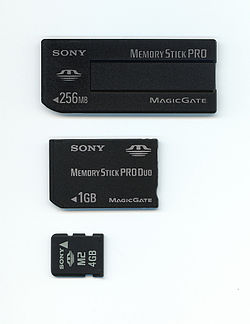
Back Memory Stick Afrikaans Memory Stick Catalan Memory Stick Czech Co-bach Welsh Memory Stick Danish Memory Stick German Memory Stick Spanish Memory Stick Finnish Memory Stick French Memory Stick Hungarian
 | |
 From top to bottom: Memory Stick PRO, Memory Stick PRO Duo, Memory Stick Micro (M2) | |
| Media type | Flash memory card |
|---|---|
| Capacity | 128 MB (Original) 32 GB (PRO series) 2 TB (XC series) |
| Developed by | Sony |
| Extended to | Memory Stick PRO, Memory Stick Duo, Memory Stick PRO Duo, Memory Stick PRO-HG Duo, and Memory Stick Micro |
The Memory Stick is a removable flash memory card format, originally launched by Sony in late 1998.[1] In addition to the original Memory Stick, this family includes the Memory Stick PRO, a revision that allows greater maximum storage capacity and faster file transfer speeds; Memory Stick Duo, a small-form-factor version of the Memory Stick (including the PRO Duo); the even smaller Memory Stick Micro (M2), and the Memory Stick PRO-HG, a high speed variant of the PRO to be used in high-definition video and still cameras.
As a proprietary format, Sony exclusively used Memory Stick on its products in the 2000s such as Cyber-shot digital cameras, Handycam digital camcorders, Sony Ericsson mobile phones, WEGA and Bravia TV sets, VAIO PCs, digital audio players, and the PlayStation Portable game console,[2] with the format being licensed to a few other companies early in its lifetime. With the increasing popularity of Secure Digital around 2010, Sony started to include SD in their devices, marking a surrender by Sony of its format war in the memory-card business and the end to further serious development of the format.[3] Despite this, Sony continues to support Memory Stick on certain newer devices through the use of adaptors.[4]
- ^ "Sony Global – Press Release – Sony Announces 'Memory Stick' Recordable IC Memory Card Products New Format Supports Recording and Playback of Audio/Video Content". Sony.net (Press release). Retrieved November 13, 2011.
- ^ "The worst storage mediums of all time – Page 3 of 4 – ExtremeTech". extremetech.com. May 15, 2014.
- ^ "The Beginning of the End of Memory Stick? Hope So!". technologizer.com. January 6, 2010.
- ^ "MS-A16G - Accessories Compatibility Information". support.d-imaging.sony.co.jp. Retrieved April 22, 2023.